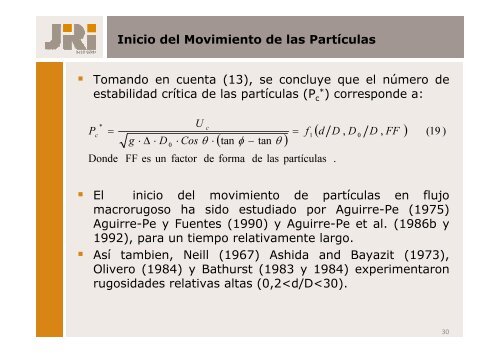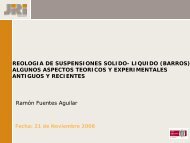Fricción, velocidad crítica y arrastre incipiente en régimen torrencial
Fricción, velocidad crítica y arrastre incipiente en régimen torrencial
Fricción, velocidad crítica y arrastre incipiente en régimen torrencial
You also want an ePaper? Increase the reach of your titles
YUMPU automatically turns print PDFs into web optimized ePapers that Google loves.
Inicio del Movimi<strong>en</strong>to de las Partículas<br />
Tomando <strong>en</strong> cu<strong>en</strong>ta (13), se concluye que el número de<br />
estabilidad <strong>crítica</strong> de las partículas (P c * ) corresponde a:<br />
P<br />
*<br />
c<br />
=<br />
Donde<br />
g<br />
FF<br />
⋅ ∆<br />
es<br />
⋅<br />
D<br />
un<br />
0<br />
factor<br />
U<br />
c<br />
⋅ Cos θ<br />
⋅<br />
de<br />
( tan φ − tan θ )<br />
forma<br />
de<br />
partículas<br />
( d D , D D , FF )<br />
El inicio del movimi<strong>en</strong>to de partículas <strong>en</strong> flujo<br />
macrorugoso ha sido estudiado por Aguirre-Pe (1975)<br />
Aguirre-Pe y Fu<strong>en</strong>tes (1990) y Aguirre-Pe et al. (1986b y<br />
1992), para un tiempo relativam<strong>en</strong>te largo.<br />
Así tambi<strong>en</strong>, Neill (1967) Ashida and Bayazit (1973),<br />
Olivero (1984) y Bathurst (1983 y 1984) experim<strong>en</strong>taron<br />
rugosidades relativas altas (0,2



